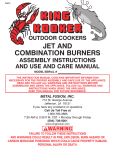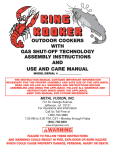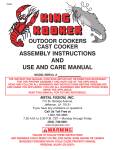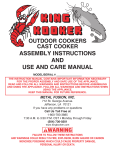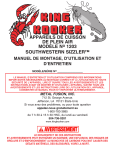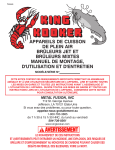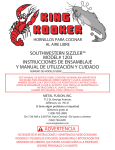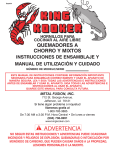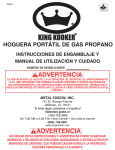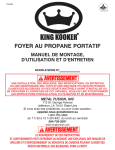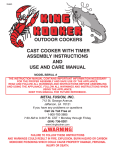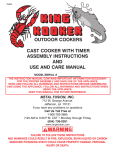Download Metal Fusion King Kooker OUTDOOR COOKER Operating instructions
Transcript
section II Use and care Throughout this manual the words appliance, cooker, fryer/boiler, burner and stove will be used interchangeably to refer to the King Kooker® Outdoor Cooker. Read and Understand before using this appliance Failure to follow these instructions and warnings could result in fire, explosion, burn hazard or carbon monoxide poisoning which could cause Property Damage, Personal Injury or Death. Thermometer Instructions and safety Precautions For Deep Frying with Outdoor Cookers 1. Always use a deep fry thermometer when using this appliance as a fryer/boiler. a. Before each use of the appliance make sure that the thermometer is properly calibrated by placing the tip in a pot of boiling water. The thermometer should register within +/-20° of 212°F or +/-10° of 100°C. If the thermometer is miscalibrated, contact Metal Fusion, Inc. to obtain a replacement before using the appliance. b. Hang the thermometer on the inside of the pot with the probe immersed in the cooking liquid. Never place a lid over a pot when monitoring the temperature of oil. c. Once the fire has been lit monitor the temperature on the thermometer at all times. Water boils at 212°F(100°C). The temperature of hot oil should never be allowed to exceed 350°F(177°C). IMPORTANT: Oil can ignite at high temperatures. Most King Kooker® thermometers have a Red Zone above 350°F(177°C) to signify Danger. Never allow the temperature to exceed 350°F(177°C). If the temperature goes above 350°F(177°C) immediately turn the burner and gas supply OFF and wait for the temperature to decrease to below 350°F(177°C) before relighting according to instructions in the manual. If at any point during the cooking process the oil begins to smoke, immediately turn the burner and gas supply OFF regardless of the reading on the thermometer. Allow time for the oil to cool, then contact Metal Fusion, Inc. for further instructions. d. When the cooking is complete and the cooker has been turned off, allow the temperature of the oil to fall below 100°F(38°C) before moving the pot, cooking oil, or cooker. e. Please call Metal Fusion, Inc. at (800) 783-3885 with any questions concerning the use or operation of the thermometer. 2. Never cover the pot when cooking with oil. 3. Always thaw and dry food completely before placing it into hot oil. Frozen or wet food may cause oil or grease to overflow. 4. Never put an empty pot over an open flame. 5. In the event of rain, snow, hail, sleet or other forms of precipitation while cooking with oil/grease, cover the cooking vessel immediately and turn off the appliance burners and gas supply. Do not attempt to move the appliance or cooking vessel. 6. When cooking with oil or grease, fire extinguishing materials shall be readily accessible. In the event of an oil or grease fire do NOT attempt to extinguish with water. Immediately call your Fire Department. A Type BC or Type ABC fire extinguisher may, in some circumstances, contain the fire. 7. This appliance is not for frying turkeys. 14 Determining proper fill levels for cooking vessels Never overfill the cooking vessel with oil, grease or water. Never fill a pot beyond the maximum fill line. If the pot being used does not have a maximum fill line, follow these instructions to determine the amount of cooking liquid to be used: a. Place the food product in or on the holder. b. Place the food product and holder into the empty vessel. c. Fill the vessel with water just until the food product is completely submerged. There must be a minimum of 3 inches (7.5 cm) between the water level and top of the vessel. d. Remove the food product from the vessel and either mark the water level on the side of the vessel or measure the amount of water in the vessel. e. Remove the water and completely dry the vessel and the food product. f. This is the amount of cooking liquid the vessel is to be filled with to cook the food product. LP gas cylinder information King Kooker® Outdoor Cookers are manufactured for use with 20lb. (9 kg) LP Gas Cylinders. Important information to remember about LP Gas cylinders include: 1. 2. Always read and follow the cylinder manufacturer’s instructions. Make sure that the gas cylinder is not overfilled. The maximum weight of a properly filled 20 lb. (9 kg) LP gas cylinder is approximately 38 lbs (17 kg). Never fill the cylinder beyond 80% full. 3. Make sure that the cylinder valve has the proper connection for a Type 1 appliance fitting. 4. Do not store a spare LP gas cylinder under or near this appliance. 5. Disconnect the cylinder from the cooker for storage. 6. Store the cylinder out of the reach of children. 7. Do not use or store the cylinder in a building, garage or enclosed area. 8. Always use a 20 lb. (9 kg) cylinder in the proper upright position for the proper vapor withdrawal. It should also be stored and transported in the upright position. 9. The cylinder must have a protective collar to protect the cylinder valve. 10. Place dust cap on cylinder valve outlet whenever the cylinder is not in use. Only install the type of dust cap on the cylinder valve outlet that is provided with the cylinder valve. Other types of caps or plugs may result in leakage of propane. 11. Cylinder must be turned OFF while not in use. always read and follow these and the cylinder manufacTurer’s instructions. Failure to follow these instructions and warnings could result in fire, explosion, burn hazard or carbon monoxide poisoning which could cause Property Damage, Personal Injury or Death. 15 Connection Instructions 1. 2. 3. Check that your hose assembly valve is set to not allow gas flow. Turn the regulator control counterclockwise until it stops. This is the OFF position. Attach the regulator to the cylinder valve by turning the Type 1 fitting clockwise. Hand tighten with the regulator positioned upright. Refer to the appropriate assembly diagram for the appliance in Section 1. Perform the Leak Test: leak test Before lighting the appliance, a thorough leak test must be satisfactorily completed using a non-ammonia soapy water solution (50% non-ammonia soap and 50% water). This is to be applied with a small brush to all gas joints after the cylinder valve is opened (no more than 1/2 turn). If bubbles are seen, indicating a leak, turn off the cylinder and tighten the leaking connection until a further leak test shows no leaks. If tightening the connection does not stop the leak, call Metal Fusion, Inc. (800) 783-3885, for assistance. NEVER USE HOSE/REGULATOR ASSEMBLY IF LEAKING. 4.When using the appliance as a Jet Burner Before lighting the cooker, check that the jet pipes and orifice are free from obstruction. The orifice under the jet tube should be positioned pointing up directly through the tube as per Figure 1. Both situations must be corrected if necessary before lighting to prevent flashback. Figure 1 ORIFICE 5.When using the appliance as a Cast Burner Before lighting the cooker, check that the venturi tube is free from obstruction and the brass adapter (with orifice) is properly threaded into the venturi tube as per Figure 2. Both situations must be corrected if necessary before lighting to prevent flashback. Figure 2 CASTING BRASS ADAPTER WITH ORIFICE VENTURI TUBE 16 FLAT BAR SUPPORT BRACKET PLACEMENT INSTRUCTIONS 1. Never operate this appliance within 10ft. (3.05m) of any structure, combustible material or other gas cylinder. Never operate this appliance within 25ft. (7.5m) of any flammable liquids or vapors 2. There must be no combustibles or roof overhead. 3. Keep 24 inches (.61 m) of space between the LP gas cylinder and the appliance as per Figure 1 (Jet Burner Assembly) and Figure 2 (Cast Burner Assembly). 4. The LP gas cylinder and appliance must be located so that any wind is blowing the heat of the appliance away from the propane cylinder. This also helps fire prevention by blowing the flames of a grease fire away from the propane cylinder. 5. Center the pot over the burner on the cooker. Do NOT use any pot larger than 120 qts. (113.56 L) [19 3/4”H (50cm) X 21 1/4”D(54cm)]. FIGURE 1 - JET BURNER ASSEMBLY Keep twenty-four inches between the cylinder and the appliance. Placing the cylinder too close to the appliance could result in fire or explosion which could cause property damage, personal injury or death. CLEAR OVERHEAD WIND DIRECTION (.61m) 24” (3.05m) (3.05m) 10 FEET 10 FEET to NEAREST COMBUSTIBLE (All Directions) to NEAREST COMBUSTIBLE (All Directions) GROUND LEVEL The hose connecting the appliance to the tank poses a trip hazard. Do not step over the hose or walk between the cylinder and appliance. Tripping could cause the appliance or cylinder to tip over, leading to fire or explosion which could cause property damage, personal injury or death. * Models may vary from picture. FIGURE 2 - CAST BURNER ASSEMBLY Keep twenty-four inches between the cylinder and the appliance. Placing the cylinder too close to the appliance could result in fire or explosion which could cause property damage, personal injury or death. CLEAR OVERHEAD WIND DIRECTION (.61m) 24” (3.05m) (3.05m) 10 FEET 10 FEET to NEAREST COMBUSTIBLE (All Directions) to NEAREST COMBUSTIBLE (All Directions) GROUND LEVEL 17 The hose connecting the appliance to the tank poses a trip hazard. Do not step over the hose or walk between the cylinder and appliance. Tripping could cause the appliance or cylinder to tip over, leading to fire or explosion which could cause property damage, personal injury or death. lighting and operating Instructions 1. 2. 3. 4. 5. The Cooker must not be lit until the preceding placement instructions have been completely followed. Never light the burner assemblies when they are not installed in the cooker frame. Make certain that the regulator control is turned to OFF by turning it counterclockwise until it reaches the stop. Open cylinder control valve by turning it counterclockwise as per the diagram (Figure 2). Insert a multipurpose lighter through the hole in the shroud as per Figure 3, or use a paper book match placed above the casting or jet pipe as per Figure 4. Turn the regulator control toward the ON position until ignition occurs. Turning the regulator control clockwise increases the gas pressure to the burner and hence the flame size (Figure 2). When lighting the cooker, if ignition does not occur in 3 to 5 seconds, turn the regulator and cylinder valve off. Wait 5 minutes for gas to disperse. Repeat procedure. Refer to Figure 5 for proper flame emission. Check that the flame is blue. When using the cast burner assembly, check that the flames are emitted from every port in the casting. If not, rotate the air shutter position until there is a blue flame. Opening the shutter too much will cause the flame to “Lift” off the burner. If there is a yellow flame when using either burner assembly, or if some ports have no flame, this indicates there may be an obstruction in the venturi tube or ports. Check the maintenance instructions on page 19 for more information. Always monitor the flame throughout the cooking process. If at any point in the cooking process the flame is accidentally extinguished, immediately turn the regulator and cylinder valve OFF. Wait 5 minutes for gas to disperse and relight the cooker according to the lighting instructions. (#1 - #5) in this section. ADJUSTABLE REGULATOR Figure 1 Turn Cylinder Handle Turn Regulator Control toward ON toward ON Next (Counterclockwise) (Clockwise) Jet Burner Assembly 20LB. LP GAS CYLINDER Cast Burner Assembly Figure 2 Multipurpose Lighter Paperbook Match Proper Flame Emission Jet Pipe Casting Figure 3 Figure 4 Figure 5 Never put hands or face directly over burner while lighting OR WHILE THE APPLIANCE IS LIT. 18 Turning off and storing the cooker after use Never Move the cooker OR POT while in use or still hot [above 100°F(38°C)]. 1. After each use turn OFF the King Kooker® at the regulator first, then at the gas cylinder valve. Check to make sure there is no flame and all valves are off. Do not leave the cooker until it has cooled completely. When removing food from the cooker wear protective mitts. 2. Disconnect the regulator from the cylinder by turning the Type 1 fitting counterclockwise until the regulator is separated from the tank. 3. Storage of this cooker indoors is permissible only if the cylinder is disconnected and removed from the cooker. Do not use or store cylinder in a building, garage or enclosed area. Read and follow cylinder manufacturer’s instructions. The cylinder must be stored out of the reach of children at all times. Keep entire unit in area to avoid insects and contamination that can clog the jet tube(s) and venturi tube. Failure to follow these instructions and warnings could result in fire, explosion, burn hazard or carbon monoxide poisoning which could cause Property Damage, Personal Injury or Death. Maintenance of outdoor cookers and accessories 1. The area where the cooker will be used must be kept clear and free from combustible materials, gasoline and other flammable vapors and liquids. Before each use of the cooker inspect and remove any combustible items. 2. The flow of combustion and ventilation of air must not be obstructed. The cooker must be set in an open area with 10ft. (3.05m) of space on all sides and no roof or overhang overhead. Check the location and placement of the cooker before each use. 3. Before each use of the appliance check the jet tubes and venturi tube on cast burners for insects, insect nests, and other obstructions. A clogged tube can lead to a fire beneath the appliance. 4. Follow all Lighting Instructions in the Use and Care section each time the cooker is used. Check the flame for proper color and appearance. The flame should burn with a primarily blue color. Jet Burner - If the jet burner flame does not appear correct, there may be an obstruction in the orifice (pg. 16). Turn off the cooker and allow time for it to cool. Remove any obstructions in the orifice using a thin wire or pin. Light the cooker again as per the instruction manual. If this does not resolve the problem, please call Metal Fusion, Inc. at 1-800-783-3885. cast Burner -If there is an obstruction in the venturi tube or a yellow flame emitted when lit and the air shutter adjustment has not solved the problem, turn off the cooker and allow time for it to cool. Disconnect the hose and brass adapter from the cooker. Remove the air shutter using a phillips head screwdriver. Check the venturi tube with a flashlight to see if there is a blockage. If a blockage is present use a wire such as a coat hanger to slide into the venturi tube to remove the blockage. Reattach the air shutter to the venturi tube using the phillips screwdriver. Assemble and light the cooker again as per the instruction manual. If this does not resolve the problem, please call Metal Fusion, Inc. at 1-800-783-3885. 5. Always use the LP Hose/Regulator assembly supplied with the appliance. Before each use of the appliance check the LP Hose for evidence of abrasion, wear, cuts or leaks. If there is any damage to the hose, the hose/regulator assembly must be replaced prior to using the appliance. Contact Metal Fusion, Inc. at (800) 783-3885 for information regarding a replacement hose assembly. Only the LP Hose/Regulator assembly specified by Metal Fusion, Inc. should be used with the appliance. 6. For purchase of any replacement parts which may have become damaged or lost, please contact Metal Fusion, Inc. at (800) 783-3885 between the hours of 7:30 am-3:30pm (CST) Monday through Friday. (continued on page 20) 19 7. Cleaning of the appliance: Cooker and LP Hose/Regulator: If necessary, remove any oil or liquid which has spilled onto the unit during cooking with mild soapy water on a rag and towel dry. Do not immerse the burner unit or hose and regulator into water as this will cause rust. Aluminum or Stainless Steel Pots: Clean after each use according to the directions below. Cast Iron Cookware: Clean after each use according to the directions below. Thermometer: Clean after each use with mild soapy water and towel dry. Do not submerge in liquid or put in dishwasher. Tips for caring for aluminum fry pans and boiling pots It is not necessary to season aluminum pots before cooking with them. Wash with a liquid dish washing detergent and towel dry. After cooking, wash aluminum pots and fry pans in hot, sudsy detergent. If grease or black soot has cooked to the outside of the pot while cooking with your outdoor cooker, scrub the outside of the pot with a steel wool scouring pad. DO NOT SPRAY OVEN CLEANER ON ALUMINUM POTS TO REMOVE GREASE OR SOOT. OVEN CLEANER WILL CAUSE THE FINISH TO BECOME DULL. If food remains stuck in the pan after cooking, add hot water and let soak. Then scrub the pan with soap and steel wool to loosen the food. If hard water causes darkening on the interior of your pot, fill to the level of the darkened area with a water and cream of tartar or vinegar solution (mixed with the concentration of three cups of water to one tablespoon cream of tartar, or vinegar). Boil five to ten minutes. Never place an empty aluminum or stainless steel pot on a lit cooker. A hole will be burned in the bottom of the pot. Discoloration, scratching, and dimpling may occur with the use of pots on outdoor cookers. This does not affect the performance of the pot. Do not store used oil inside your aluminum pot. The salt used in cooking can corrode the pot causing the pot to leak. Wash the pot after each use with hot, soapy water and rinse. seasoning & care of cast iron cookware New Cast Iron Pots are coated with paraffin to prevent rusting. Before using for the first time, wash with mild soapy water, rinse, and dry thoroughly. Never use abrasive detergents. Grease the entire surface of the cookware with a thin coating of solid vegetable shortening. Do not use salted fat (margarine or butter). Heat for 30-60 minutes in oven at 300-350°F (149-177°C.) Remove from oven, pour out excess grease, and wipe with a paper towel. This completes the seasoning process. Each time the cast iron is used, coat the entire surface with a thin coat of solid vegetable shortening, wipe with a paper towel, and store. information regarding cooking oil In our instructions we suggest peanut oil for deep frying. While this is an excellent choice, any good liquid vegetable oil may be substituted. suggestions for keeping used cooking oil: After initial use, let the oil cool. While slightly warm, filter out particles before storing in original container or similar sturdy plastic or glass container. This can be accomplished by using filter paper (coffee filters) or a clean cloth (dishtowel). Never pour hot oil into a container. For best results store oil in a cool place. It can be reused within 30 days. Discard after second use or when the flavor of reheated oil becomes objectionable to taste. Helpful Hint: Try frying a batch of french fried potatoes after cooking. This aids in improving the flavor of the oil for the next use. 20 section III Recipes from The King of Outdoor Cooking™ For more great recipes and products check our website at www.kingkooker.com Boiled Seafood! The King Kooker® Way! For a 60 to 100 quart pot, fill 1/2 full of water. Add 4 to 6, 16 ounce King Kooker® Complete Crab, Shrimp, Crawfish ,Boil (complete, nothing to add). Bring water to a rolling boil. Add seafood. Gently stir. Cover the pot and return to boil. Boiling times: Shrimp - 2 minutes; Crawfish - 5 minutes; Crabs - 5 minutes. Cut off the fire. Gently stir the seafood again and let it soak. Add one 8 ounce King Kooker® Liquid Crab Boil. Soaking time: Shrimp - 15 to 20 minutes; Crawfish and Crabs - 15 to 20 minutes. Seafoods tend to float on the surface while soaking. On the surface they do not thoroughly absorb the seasoning. Add the equivalent of four trays of ice to the pot, allowing it to float on the surface of the liquid. This sudden change of temperature causes the seafood to sink and to draw in the great flavor of King Kooker® seasoning. A Little Extra To complement your seafood, try including a few pounds of creamer potatoes, a dozen ears of corn, a pound of fresh mushrooms, five or six cloves of garlic, fresh peeled onions, hot dogs, smoked sausage or andouille sausage. Hint: Allow potatoes extra cooking time by adding them to the boiling seasoned water 5 to 10 minutes before adding the seafood. Blackened Fish Heat a cast iron skillet for at least ten minutes on your King Kooker®. Allow the skillet to get almost white hot -- hot enough to see the “flame circle” in the center of the skillet. This recipe produces lots of smoke. Fish fillets should be 1/2” (1.25 cm) thick for best results. Dip fillets in melted butter or margarine and shake King Kooker® Blackened Redfish Seasoning on both sides of fillets. Drop into the skillet and cook for 45 seconds on each side. Serve piping hot. Barbecue Shrimp Ingredients: 2 lbs. large shrimp, 1 stick butter or margarine, 4 tablespoons King Kooker® Blackened Redfish Seasoning. Melt butter over medium heat in a pot large enough to hold all ingredients. Add seasonings and shrimp. Cover the pot and cook for 10 minutes. Stir occasionally. Shrimp are ready when they are a pretty pink color. Fried Seafood Wash and drain seafood. Remove any excess moisture. This will reduce splashing and popping in hot oil. Thoroughly coat seafood with King Kooker® Seasoned Fish Fry. Place in oil or shortening at 325 - 350°F (163-177°C) and cook until golden brown on all sides. Heavier breading may be obtained by dipping seafood in a mixture of egg and milk before coating with seasoned fish fry. Steamed Clams or Mussels Clean clams thoroughly in cold water, scrubbing with a brush. Discard any that float. Place clams on steamer plate in basket. Pour enough water into pot to come up to bottom of steamer rack when in pot. Bring water to a boil and cover. The clams are cooked when the shells open. Any shells which do not open should be discarded. Remove from heat. Too much cooking will toughen the clams. Serve with drawn or melted butter. Steamed Blue Crabs, Shrimp, or Lobsters Place water in the pot up to the bottom of the steaming plate. You can replace one half of a gallon of the water with 1/2 gallon of vinegar if you would like. Add 2 1/2 tablespoons of steamer seasoning and 3 tablespoons salt to water/vinegar mixture. Place the steamer rack into the pot and layer the seafood on the steamer rack, sprinkling each layer generously with steamer seasoning. Salt to taste. Cover and steam until crabs or lobsters turn red (approximately 20-25 minutes). Steam shrimp (approximately 10-15 minutes), the meat will pull away from the shell when done. For extra flavor pour two ounces of King Kooker® Liquid Crab Boil into the water/ vinegar mixture. (Make sure to never allow all of the steaming liquid to evaporate. A hole will be burned into the bottom of an empty pot on a lit cooker.) We recommend King Kooker® Complete Crab, Shrimp, Crawfish Boil to add flavor to all your steamed seafoods and vegetables. 21 King Kooker® Beans Ingredients: 2 - 64 oz. cans of Pork & Beans, 2 - large white finely chopped onions, 1 bell pepper finely chopped, 1 - bunch of shallots finely chopped, 1/2 bunch of celery finely chopped, 1 lb. ground meat, 1 lb. sliced bacon, 1 lb. light brown sugar, 1 -8 oz. bottle of honey, 1 - King Kooker® Gourmet Barbecue Sauce, 3 oz. King Kooker® Cajun Seasoning, Olive Oil for sauteing seasonings. Directions: Brown off the ground meat. Drain off and dispose of the fat. Set aside the ground meat. Cut the bacon into thirds. Fry the bacon. Drain off and dispose of the fat. Set aside the bacon. Pour a few ounces of olive oil into the pot. Place the onion, bell pepper, shallots and celery into the olive oil. Saute until the onions are clear. Add all remaining ingredients, including meat and bacon. Stir, cover and cook for sixty minutes over low heat. Stir often during cooking to prevent sticking. King Kooker® Jambalaya Ingredients: 2 cans chicken broth, Tabasco, minced garlic, 4 oz. Kitchen Bouquet, 2 cans sliced mushrooms, 2 onions finely cut, 2 bell peppers finely cut, 2 lbs. smoked sausage, 1 lb. hot sausage or andouille, 8 bags of King Kooker® Jambalaya Mix, 1 lb. bacon, water. Fry off 1 lb. bacon (cubed) in small amount of cooking oil, then remove. Brown all meat, then remove. Place onions and bell peppers into pot and cook until soft. Put all meat back in except bacon. Add chicken broth, mushrooms, Kitchen Bouquet (4 oz. bottle), minced garlic (3 to 4 tbsp.), and Tabasco Hot Sauce (6 tbsp.) Add enough water to fill 3/4 of pot and bring to slow boil. Add 8 bags jambalaya mix. Bring back to slow boil. Boil 5 minutes. Stir occasionally to prevent rice from sticking. Turn fire off, cover, and let stand 20 to 25 minutes. Makes approximately 32 servings. Fried Chicken Ingredients: Chicken, oil, milk, eggs, King Kooker® Chicken Fry, skillet or aluminum pot. Cut, wash and drain chicken pieces. Dip pieces into a mixture of beaten egg and milk. Coat with King Kooker® Chicken Fry. Heat oil to 350°F (177°C). Place chicken into oil and cook until done. Cooking outdoors with a large skillet allows for larger quantities to be prepared in less time. Fried Onion Rings Ingredients: Colossal onions (if available), 2 beaten eggs, 1/2 cup milk, flour, King Kooker® Onion Mum Seasoning. Cut onions into rings, wash and drain. Blend eggs and milk in a bowl for dipping. Dip each onion ring into egg and milk mixture, then into flour. Dip onion ring again in the egg and milk mixture, then coat with King Kooker® Onion Mum Seasoning. Heat oil to 350°F (177°C). Drop onion rings one at a time into the heated oil. When the rings float to the top, remove from oil. Serve warm. Fried Mushrooms Ingredients: Mushrooms, water, oil, King Kooker® Seasoned Fish Fry. Slice mushrooms 1/8” (.32cm) thick and submerge in water to wet the slices. Coat slices thoroughly with King Kooker® Seasoned Fish Fry. Heat oil to 350°F (177°C). Place the mushroom slices into heated oil. When the mushroom slices float to the top, remove from oil. Serve warm. King Kooker® Wings Ingredients: 3-5 lb. thawed and dried wings, King Kooker® Cajun Seasoning, cooking oil, wing sauce of flavor of choice. Heat the cooking oil to 325°F (163°C). Coat the wings with King Kooker® Cajun Seasoning. Place some of the wings carefully into the heated cooking oil. Cook until the wings float and appear done. Remove the batch from the grease carefully with a skimmer long enough to keep hands away from hot oil. Check a wing for doneness. If done, add a few more wings to cook the next batch. Always monitor the temperature of the oil to keep it at 325°F (163°C). After removing the wings from the oil, dip them into the wing sauce of choice. 22 section IV Read and understand all instructions before using your king kooker® product Frequently Asked Questions and Answers 1.What is the problem if the cooker takes too long or will not heat oil or cooking ingredients to desired temperature? My cooker’s flame appearance is very weak. Answer: If the hose assembly has a Type 1 Connection (black/green knob), it is equipped with a flow limiting device. This device is intended to limit the flow of gas should there be a leak between the regulator and the appliance. To achieve a positive gas seal, which will allow for maximum gas flow, the regulator control must be set to a completely OFF position before the cylinder valve is opened. A good tip to remember is “Tank Is First On, Last Off.” The Problem Can Be Remedied in Two Ways: A. B. 1. Turn the regulator control to the OFF position. Close the tank valve completely by turning it clockwise until it stops. 2. Check that the Type 1 Connection (black/green knob) is completely tightened to the tank valve. 3. Wait 5 seconds for the pressure to equalize and for the flow limiting device to reset. 4. Turn tank valve on (counterclockwise.) 5. Turn the regulator control to an ON position. 6. Relight cooker following all lighting instructions contained in this manual. Check for proper flame characteristics. or 1. Turn the regulator control to the OFF position. Close the tank valve completely by turning it clockwise until it stops. 2. Remove Type 1 Connection (black/green knob) from the tank valve. The flow limiting device will now reset. 3. Re-attach Type 1 Connection (black/green knob) to the tank valve. Tighten completely. 4. Turn tank valve on (counterclockwise.) 5. Turn the regulator control to an ON position. 6. Relight cooker following all lighting instructions contained in this manual. Check for proper flame characteristics. 2.How long will the propane in my tank last? Answer: On average, a full tank will give you 4 to 5 hours of normal cooking. 3. I have a new style tank and it won’t connect to my regulator. What do I do? Answer: The regulator supplied with this appliance has a Type 1 Connection which will attach to the tank valve which has large threads on the valve outlet. These connect into the large plastic handnut (black or green). This tank will also connect to earlier models of Metal Fusion cooker regulators which had a brass plug connector with left hand threads, which will connect to the internal threads of the Type 1 tank valve (with a wrench). If your tank has a quick disconnect valve (plug in type) our regulators can not connect to this tank. 4. I have a brand new cooker and I cannot get the burner to light. What’s the problem? Answer: Make sure the tank has been filled with propane. Tanks purchased from the store shelf are most often sold empty. If this does not solve the problem refer to Maintenance Instruction items #3 and #4, page 19. If you have questions please call Metal Fusion, Inc. at (800) 7833885. IF YOU HAVE A QUESTION WE HAVE NOT ADDRESSED IN THIS MANUAL PLEASE SEND US AN E-MAIL AT [email protected] OR CALL 1-800-783-3885 BETWEEN 7:30 A.M. AND 3:30 P.M. CST MONDAY THROUGH FRIDAY. 23 or go to www.kingkooker.com , King GrilleRDine®, King Kooker®, the King Kooker® logo, The King®, the KING OF OUTDOOR COOKING®, Mr. Outdoors®, and WATCHDOG OUTDOOR COOKER SERIES® are trademarks of Metal Fusion, Inc., 712 St. George Avenue, Jefferson, LA 70121 Rev. 03/2011-E











